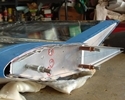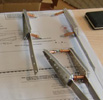


random user submitted photo
Engine mounts sagging
Re: Engine mounts sagging
*
Last edited by daleandee on Sun Apr 30, 2017 8:35 pm, edited 1 time in total.
-

daleandee - Posts: 877
- Joined: Fri Feb 01, 2013 6:14 pm
Re: Engine mounts sagging
The Jabiru and VW type engine mount to accessory plate attachments are almost the same in type. Looking at my plans there is a substantial difference between the size of the VW engine mount steel bushing, which the rubber fits over, compared to the Jabiru mount bushing.
VW mount 3/8"
Jabiru mount 3/4"
Could this also contribute to the VW mount being more prone to distorting the rubbers?
Steve
Sonex 892
VW mount 3/8"
Jabiru mount 3/4"
Could this also contribute to the VW mount being more prone to distorting the rubbers?
Steve
Sonex 892
Steve
Lazair kit 1981 sold
Sonerai 2LS plansbuilt 2003 sold
Sonex kit 2010
Sonerai 2LS project rotax 912
Lazair kit 1981 sold
Sonerai 2LS plansbuilt 2003 sold
Sonex kit 2010
Sonerai 2LS project rotax 912
-

sonex892. - Posts: 414
- Joined: Tue Oct 27, 2015 12:32 am
Re: Engine mounts sagging
I'd like to back up Steve's observation here because I went one better. For unrelated reasons I was forced to bush up the Jabiru mount from 5/8 to 7/8 using Delrin. This also entailed boring out the standard Jabiru engine mount rubbers to 7/8. The motor has been hanging on those rubbers for about 7 years now and hasn't shifted. I don't know if this is an option for the Aerovee, but it would make sense if the smaller bush on the Aerovee mount is causing a too high bearing stress in the rubber. Doubling the bearing area by bushing to 3/4 say might eliminate the problem.
Peter
Sonex 894
Peter
Sonex 894
- peter anson
- Posts: 558
- Joined: Thu Jul 31, 2014 2:34 am
- Location: Mount Macedon, Australia
Re: Engine mounts sagging
Hi all
I agree with dale if there was a vertical stay in between the top and bottom mounts there would be a lot less wear on the mounts. The top mounts are not really bearing any of the engine weight in their current configuration
I currently get about 50 hrs at best from the bottom set where as the top ones show much less wear after the same period
Regards Bish
I agree with dale if there was a vertical stay in between the top and bottom mounts there would be a lot less wear on the mounts. The top mounts are not really bearing any of the engine weight in their current configuration
I currently get about 50 hrs at best from the bottom set where as the top ones show much less wear after the same period
Regards Bish
- bishoff7
- Posts: 21
- Joined: Sat Jan 12, 2013 3:35 am
Re: Engine mounts sagging
Does anyone who is using either the summit pn ENS 9.8122R or the spf2092bk bushings have an update that they would like to share on how they are working? Thanks.
Jeffrey W
Waiex 0196
AeroVee Turbo
Waiex 0196
AeroVee Turbo
- jeff0196
- Posts: 44
- Joined: Mon Mar 13, 2017 10:16 pm
- Location: SE Wisconsin
Re: Engine mounts sagging
With no cowl and the project paused, so far they are flawless!
Bryan Cotton
Poplar Grove, IL C77
Waiex 191 N191YX
Taildragger, Aerovee, acro ailerons
dual sticks with sport trainer controls
Prebuilt spars and machined angle kit
Year 2 flying and approaching 200 hours December 23
Poplar Grove, IL C77
Waiex 191 N191YX
Taildragger, Aerovee, acro ailerons
dual sticks with sport trainer controls
Prebuilt spars and machined angle kit
Year 2 flying and approaching 200 hours December 23
-

Bryan Cotton - Posts: 5489
- Joined: Mon Jul 01, 2013 9:54 pm
- Location: C77
Re: Engine mounts sagging
Has anyone found a good solution for solving Aerovee engine sag? Is there a better alternative to the AeroConversions rubber bushings? If someone has found something better, would appreciate info on where to get them. On my third set of bushings from Sonex and finding its a waste of time to keep installing parts that have no operating life. Talked with Sonex folks at OSH this year and of course they had not heard of any problems with engine sag. Any and all info appreciated. Thanks.
- Dennis W.
- Posts: 29
- Joined: Sat May 13, 2017 8:25 am
Re: Engine mounts sagging
I noticed mine seemed to be extruding around the engine mount, so I cut a couple "slotted washers" out of aluminum large enough to back them up. The slot made them easy to install without removing the engine--just loosen the bolts and lift the engine a little to slip them in. I don't remember the thickness I used, but probably a little less than 1/8".
A couple years later I noticed the bottom ones seem to be more affected by the heat of the nearby exhaust, so I installed deflector shields on the exhaust pipe nearby partially to fix that problem and partially since it seemed smart to reduce the heat radiating on the carburetor.
I'm still on my first set after ~3 years and ~250+ hours, but there's probably room for improvement.
If true, it's funny the factory hasn't heard of this problem. I feel like I see it come up here fairly regularly.
A couple years later I noticed the bottom ones seem to be more affected by the heat of the nearby exhaust, so I installed deflector shields on the exhaust pipe nearby partially to fix that problem and partially since it seemed smart to reduce the heat radiating on the carburetor.
I'm still on my first set after ~3 years and ~250+ hours, but there's probably room for improvement.
If true, it's funny the factory hasn't heard of this problem. I feel like I see it come up here fairly regularly.
- gammaxy
- Posts: 600
- Joined: Wed Sep 04, 2013 9:31 am
Re: Engine mounts sagging
You might want to reach out to Mike Smith. He dealt with the same issue and has a solution that seems to be working reasonably well.
[color=#800000]Kevin Conklin
Building Waiex #169
Building Waiex #169
- dbdevkc
- Posts: 193
- Joined: Sun Jun 26, 2011 9:18 am
- Location: Washingtonville, NY
Re: Engine mounts sagging
I'm convinced it's happening because there is no braced connection between the upper and lower engine mount arms. The engine is pivoting on the upper arms and that's banging the lower rubber mounts into the lower mount pins, elongating the holes and the rubber mounts.
I think adding a brace between the upper and lower arms would solve everything, since the engine could not pivot any more. But I'm not a skilled welder and haven't wanted to do the major surgery to have someone else do it.
So another AeroVee guy made a couple of molds to match the shape of the rubber mounts, and then he and I experimented with different polyurethane mixes to get something firmer than the factory mounts. I then used shorter engine mount bolts than on the plans, since the ones sized per the plans will allow the nuts to bottom out on the shoulders of the bolts, making you only "think" you have the nut as tight as it can go on the mounts.
What we used: PMC-780 DRY which is a Shore 80A liquid rubber formulated for making industrial parts. It came from Mold Making & Casting Materials | Rubbers, Plastics, Foams & More!, https://www.smooth-on.com/
Doing some internet searching I was looking at these sources for polyurethane:
https://www.summitracing.com/parts/tes- ... gJbpfD_BwE
http://www.reynoldsam.com/product/reoflex-series/
http://www.energysuspensionparts.com/diymmi
https://www.mcmaster.com/#catalog/117/3599/=fnz7bt
https://www.smooth-on.com/products/reoflex-60/
From last year to this year (annual to annual) my engine shifted a bit, but not a lot. I put a jack under the engine and took the weight off the mounts, then recentered and retightened the rubber mounts and the nuts.
I have scale drawings of the rubber mounts if anyone wants to make their own molds.
I think adding a brace between the upper and lower arms would solve everything, since the engine could not pivot any more. But I'm not a skilled welder and haven't wanted to do the major surgery to have someone else do it.
So another AeroVee guy made a couple of molds to match the shape of the rubber mounts, and then he and I experimented with different polyurethane mixes to get something firmer than the factory mounts. I then used shorter engine mount bolts than on the plans, since the ones sized per the plans will allow the nuts to bottom out on the shoulders of the bolts, making you only "think" you have the nut as tight as it can go on the mounts.
What we used: PMC-780 DRY which is a Shore 80A liquid rubber formulated for making industrial parts. It came from Mold Making & Casting Materials | Rubbers, Plastics, Foams & More!, https://www.smooth-on.com/
Doing some internet searching I was looking at these sources for polyurethane:
https://www.summitracing.com/parts/tes- ... gJbpfD_BwE
http://www.reynoldsam.com/product/reoflex-series/
http://www.energysuspensionparts.com/diymmi
https://www.mcmaster.com/#catalog/117/3599/=fnz7bt
https://www.smooth-on.com/products/reoflex-60/
From last year to this year (annual to annual) my engine shifted a bit, but not a lot. I put a jack under the engine and took the weight off the mounts, then recentered and retightened the rubber mounts and the nuts.
I have scale drawings of the rubber mounts if anyone wants to make their own molds.
Mike Smith
Sonex N439M
Scratch built, AeroVee, Dual stick, Tail dragger
http://www.mykitlog.com/mikesmith
Sonex N439M
Scratch built, AeroVee, Dual stick, Tail dragger
http://www.mykitlog.com/mikesmith
- mike.smith
- Posts: 1430
- Joined: Tue Jan 29, 2013 8:45 pm
Who is online
Users browsing this forum: No registered users and 12 guests







